Paper Menu >>
Journal Menu >>
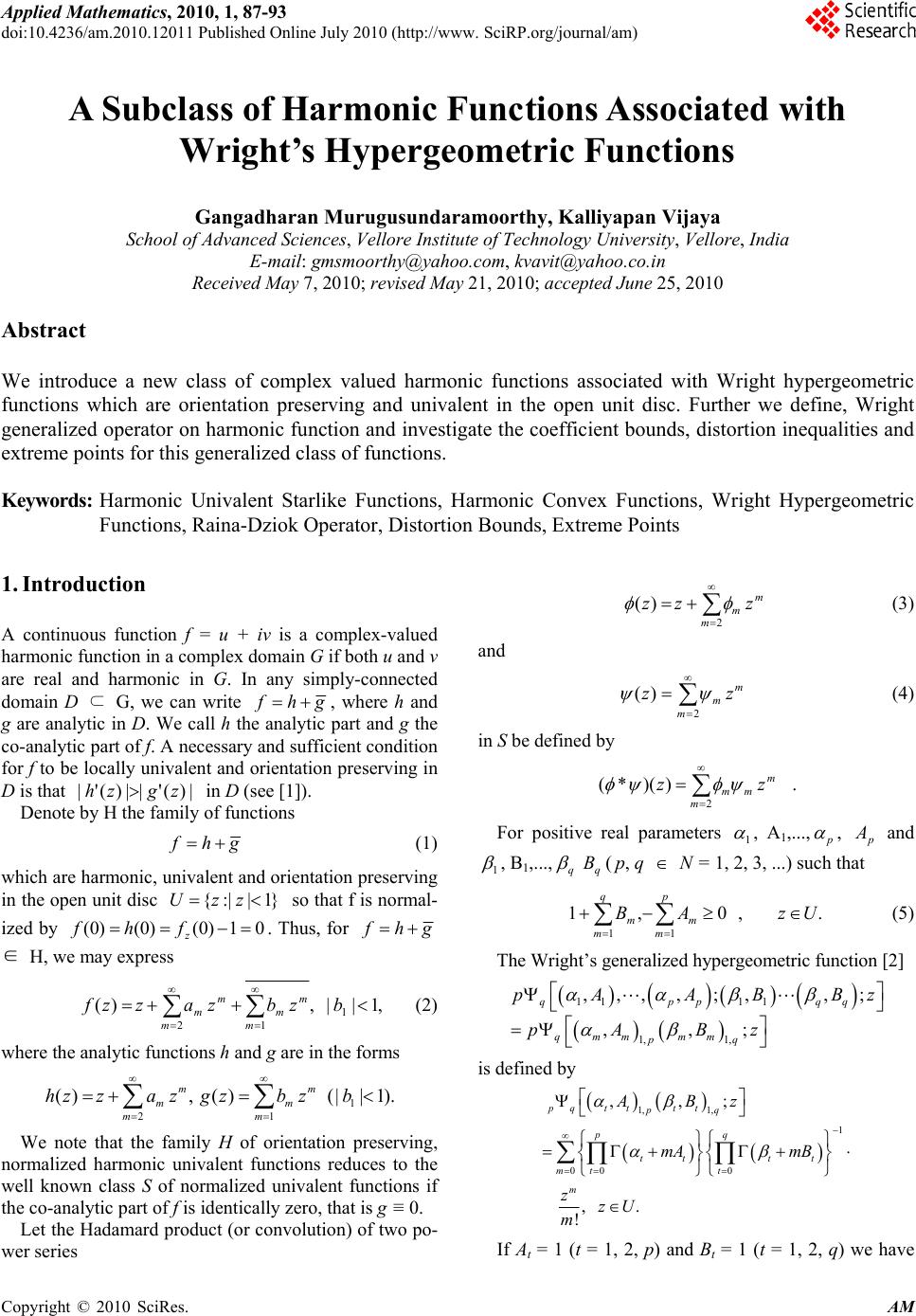 Applied Mathematics, 2010, 1, 87-93 doi:10.4236/am.2010.12011 Published Online July 2010 (http://www. SciRP.org/journal/am) Copyright © 2010 SciRes. AM A Subclass of Harmonic Functions Associated with Wright’s Hypergeometric Functions Gangadharan Murugusundaramoorthy, Kalliyapan Vijaya School of Advanced Sciences, Vellore Institute of Technology University, Vellore, India E-mail: gmsmoorthy@yahoo.com, kvavit@yahoo.co.in Received May 7, 2010; revised May 21, 2010; accepted June 25, 2010 Abstract We introduce a new class of complex valued harmonic functions associated with Wright hypergeometric functions which are orientation preserving and univalent in the open unit disc. Further we define, Wright generalized operator on harmonic function and investigate the coefficient bounds, distortion inequalities and extreme points for this generalized class of functions. Keywords: Harmonic Univalent Starlike Functions, Harmonic Convex Functions, Wright Hypergeometric Functions, Raina-Dziok Operator, Distortion Bounds, Extreme Points 1. Introduction A continuous function f = u + iv is a complex-valued harmonic function in a complex domain G if both u and v are real and harmonic in G. In any simply-connected domain D ⊂ G, we can write ghf , where h and g are analytic in D. We call h the analytic part and g the co-analytic part of f. A necessary and sufficient condition for f to be locally univalent and orientation preserving in D is that |)('||)('| zgzh in D (see [1]). Denote by H the family of functions ghf (1) which are harmonic, univalent and orientation preserving in the open unit disc }1|:|{ zzU so that f is normal- ized by 01)0()0()0( z fhf. Thus, for ghf ∈ H, we may express ,1||,)( 1 12 bzbzazzf m m m m m m (2) where the analytic functions h and g are in the forms 1 21 (),()(|| 1). mm mm mm hzzazgzb zb We note that the family H of orientation preserving, normalized harmonic univalent functions reduces to the well known class S of normalized univalent functions if the co-analytic part of f is identically zero, that is g ≡ 0. Let the Hadamard product (or convolution) of two po- wer series 2 )( m m mzzz (3) and 2 )( m m mzz (4) in S be defined by 2 ))(*( m m mm zz . For positive real parameters 1 , A1,..., p , p A and 1 , B1,..., q q B( p, q N = 1, 2, 3, ...) such that .,0,1 11 UzAB p m m q m m (5) The Wright’s generalized hypergeometric function [2] 11 11 1, 1, ,,, ,;,, ; ,,; qppqq qmm mm pq pA ABBz pABz is defined by 1, 1, 1 000 ,,; ,. ! pq tttt pq pq tt tt mtt m ABz mA mB zzU m If At = 1 (t = 1, 2, p) and Bt = 1 (t = 1, 2, q) we have 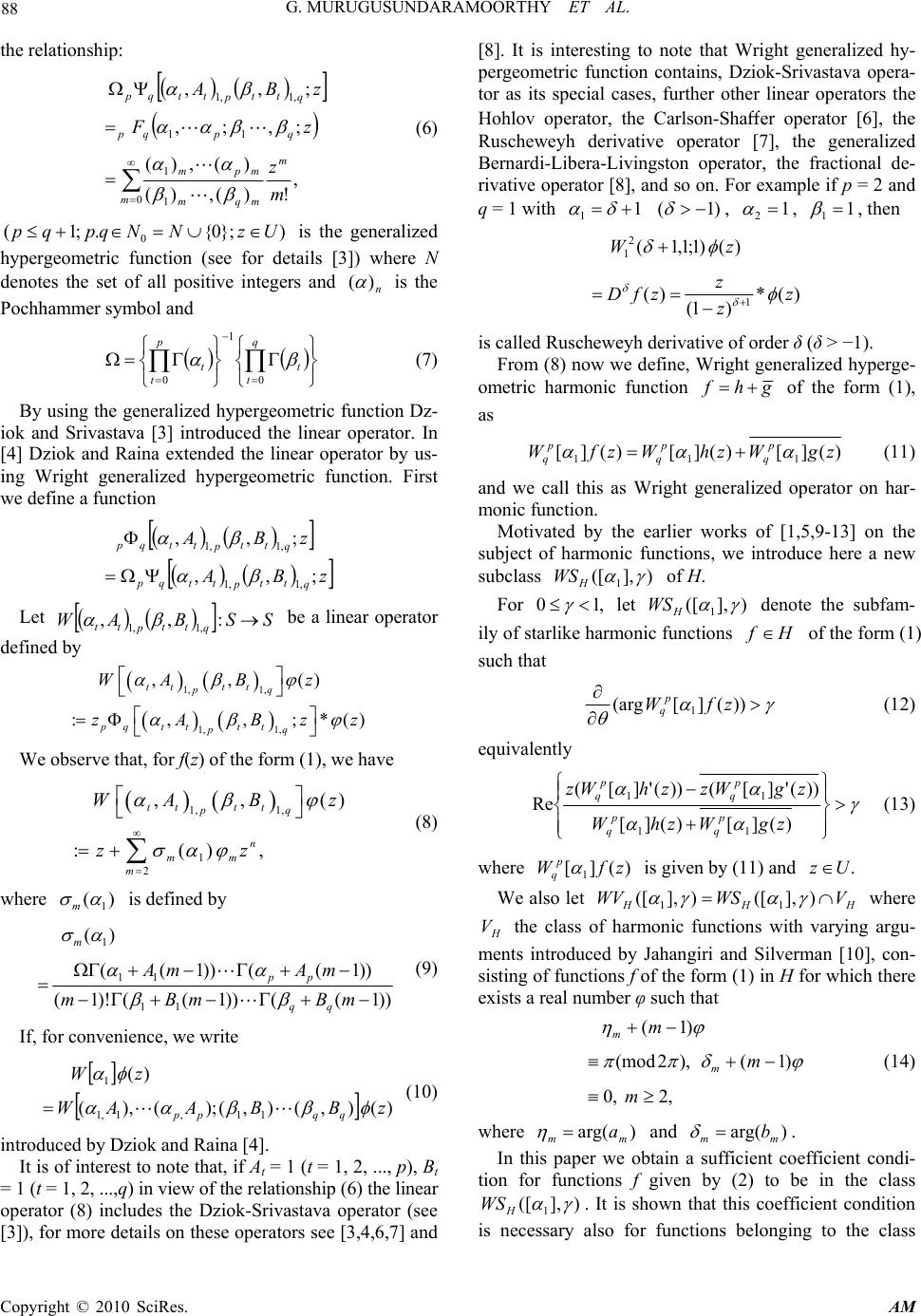 G. MURUGUSUNDARAMOORTHY ET AL. Copyright © 2010 SciRes. AM 88 the relationship: , !)(,)( )(,)( ;,;, ;,, 01 1 11 ,1,1 m z zF zBA m mmqm mpm qpqp q tt p ttqp (6) )};0{.;1( 0UzNNqpqp is the generalized hypergeometric function (see for details [3]) where N denotes the set of all positive integers and n )( is the Pochhammer symbol and q t t p t t 0 1 0 (7) By using the generalized hypergeometric function Dz- iok and Srivastava [3] introduced the linear operator. In [4] Dziok and Raina extended the linear operator by us- ing Wright generalized hypergeometric function. First we define a function zBA zBA q tt p ttqp q tt p ttqp ;,, ;,, ,1,1 ,1,1 Let SSBAWq tt p tt:,,,1,1 be a linear operator defined by 1, 1, 1, 1, ,,() :,,;*() tt tt pq pq tttt pq WAB z zABzz We observe that, for f(z) of the form (1), we have 1, 1, 1 2 ,,() :(), tt tt pq n mm m WAB z zz (8) where )( 1 m is defined by ))1(())1(()!1( ))1(())1(( )( 11 11 1 mBmBm mAmA qq pp m (9) If, for convenience, we write )(),(),();(),( )( 11,1,1 1 zBBAAW zW qqpp (10) introduced by Dziok and Raina [4]. It is of interest to note that, if At = 1 (t = 1, 2, ..., p), Bt = 1 (t = 1, 2, ...,q) in view of the relationship (6) the linear operator (8) includes the Dziok-Srivastava operator (see [3]), for more details on these operators see [3,4,6,7] and [8]. It is interesting to note that Wright generalized hy- pergeometric function contains, Dziok-Srivastava opera- tor as its special cases, further other linear operators the Hohlov operator, the Carlson-Shaffer operator [6], the Ruscheweyh derivative operator [7], the generalized Bernardi-Libera-Livingston operator, the fractional de- rivative operator [8], and so on. For example if p = 2 and q = 1 with 1 1 )1( , 1 2 , 1 1 , then )(* )1( )( )()1;1,1( 1 2 1 z z z zfD zW is called Ruscheweyh derivative of order δ (δ > −1). From (8) now we define, Wright generalized hyperge- ometric harmonic function ghf of the form (1), as )(][)(][)(][ 111 zgWzhWzfW p q p q p q (11) and we call this as Wright generalized operator on har- monic function. Motivated by the earlier works of [1,5,9-13] on the subject of harmonic functions, we introduce here a new subclass )],([ 1 H WS of H. For ,10 let )],([1 H WS denote the subfam- ily of starlike harmonic functions Hf of the form (1) such that ))(][(arg 1zfWp q (12) equivalently )(][)(][ ))('][())('][( Re 11 11 zgWzhW zgWzzhWz p q p q p q p q (13) where )(][ 1zfW p q is given by (11) and .Uz We also let HHHVWSWV )],([)],([ 11 where H V the class of harmonic functions with varying argu- ments introduced by Jahangiri and Silverman [10], con- sisting of functions f of the form (1) in H for which there exists a real number φ such that ,2,0 )1(),2(mod )1( m m m m m (14) where )arg( mma and )arg(mmb . In this paper we obtain a sufficient coefficient condi- tion for functions f given by (2) to be in the class )],([ 1 H WS . It is shown that this coefficient condition is necessary also for functions belonging to the class 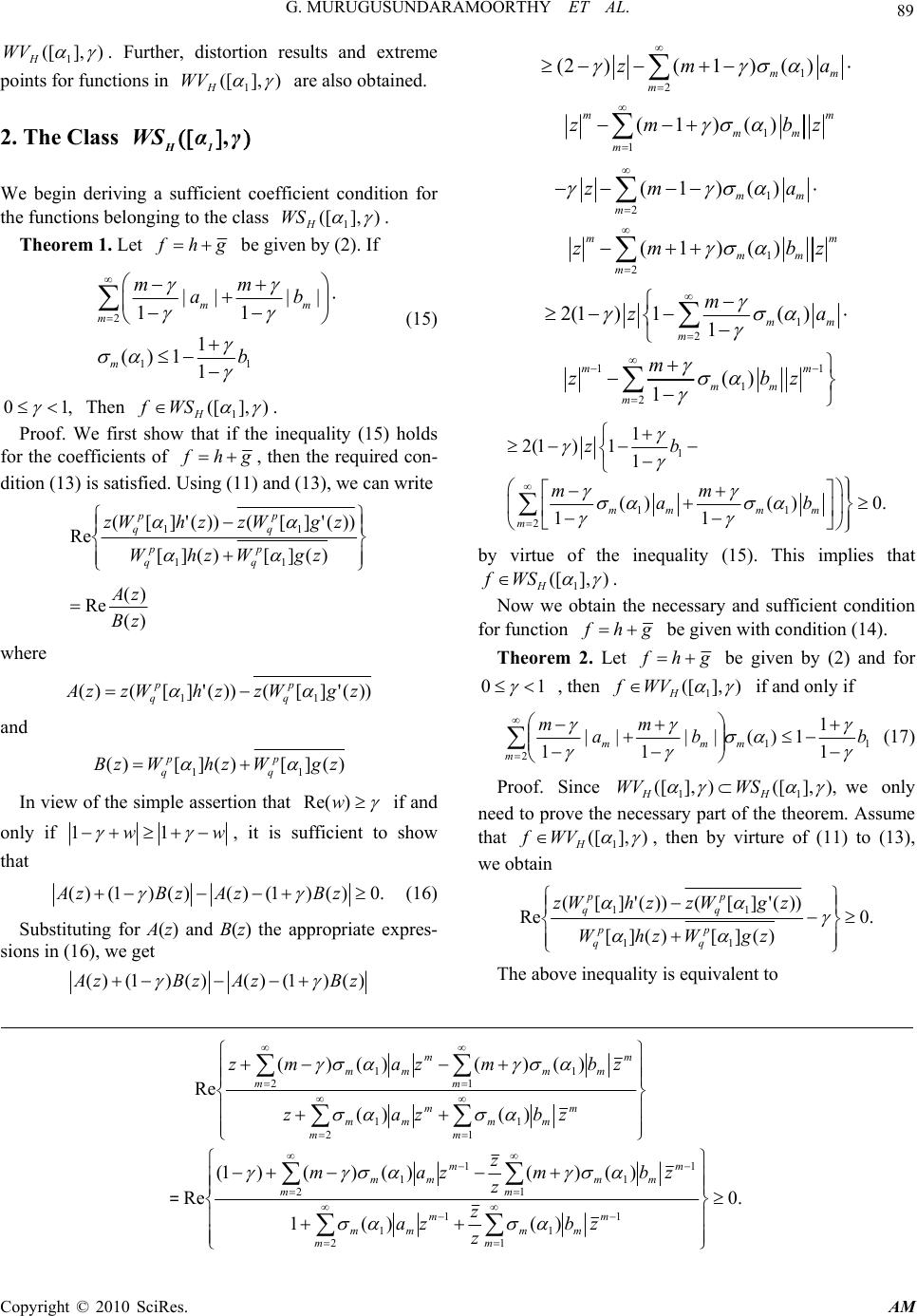 G. MURUGUSUNDARAMOORTHY ET AL. Copyright © 2010 SciRes. AM 89 )],([ 1 H WV . Further, distortion results and extreme points for functions in )],([ 1 H WV are also obtained. 2. The Class , H1 WS α γ We begin deriving a sufficient coefficient condition for the functions belonging to the class )],([ 1 H WS . Theorem 1. Let ghf be given by (2). If 2 11 || || 11 1 ()1 1 mm m m mm ab b (15) ,10 Then )],([ 1 H WSf . Proof. We first show that if the inequality (15) holds for the coefficients of ghf , then the required con- dition (13) is satisfied. Using (11) and (13), we can write )( )( Re )(][)(][ ))('][())('][( Re 11 11 zB zA zgWzhW zgWzzhWz p q p q p q p q where ))('][())('][()( 11zgWzzhWzzA p q p q and )(][)(][)( 11 zgWzhWzB p q p q In view of the simple assertion that )Re( w if and only if 11ww , it is sufficient to show that ()(1) ()()(1) ()0.AzBz AzBz (16) Substituting for A(z) and B(z) the appropriate expres- sions in (16), we get ()(1) ()()(1)() A zBzAzBz 1 2 1 1 (2)(1)( ) (1)() mm m mm mm m zm a zm bz 1 2 1 2 (1)() (1)() mm m mm mm m zm a zm bz 1 2 11 1 2 2(1)1( ) 1 () 1 mm m mm mm m m za m zbz 1 11 2 1 2(1)1 1 ()() 0. 11 mm mm m zb mm ab by virtue of the inequality (15). This implies that )],([ 1 H WSf . Now we obtain the necessary and sufficient condition for function ghf be given with condition (14). Theorem 2. Let ghf be given by (2) and for 10 , then )],([ 1 H WVf if and only if 11 21 1 1)(|| 1 || 1bb m a m m m mm (17) Proof. Since ),],([)],([ 11 HHWSWV we only need to prove the necessary part of the theorem. Assume that )],([ 1 H WVf , then by virture of (11) to (13), we obtain .0 )(][)(][ ))('][())('][( Re 11 11 zgWzhW zgWzzhWz p q p q p q p q The above inequality is equivalent to m m mm m m mm m m mm m m mm zbzaz zbmzamz 1 1 2 1 1 1 2 1 )()( )()()()( Re =.0 )()(1 )()()()()1( Re 1 1 1 1 2 1 1 1 1 1 2 1 m m mm m m mm m m mm m m mm zb z z za zbm z z zam 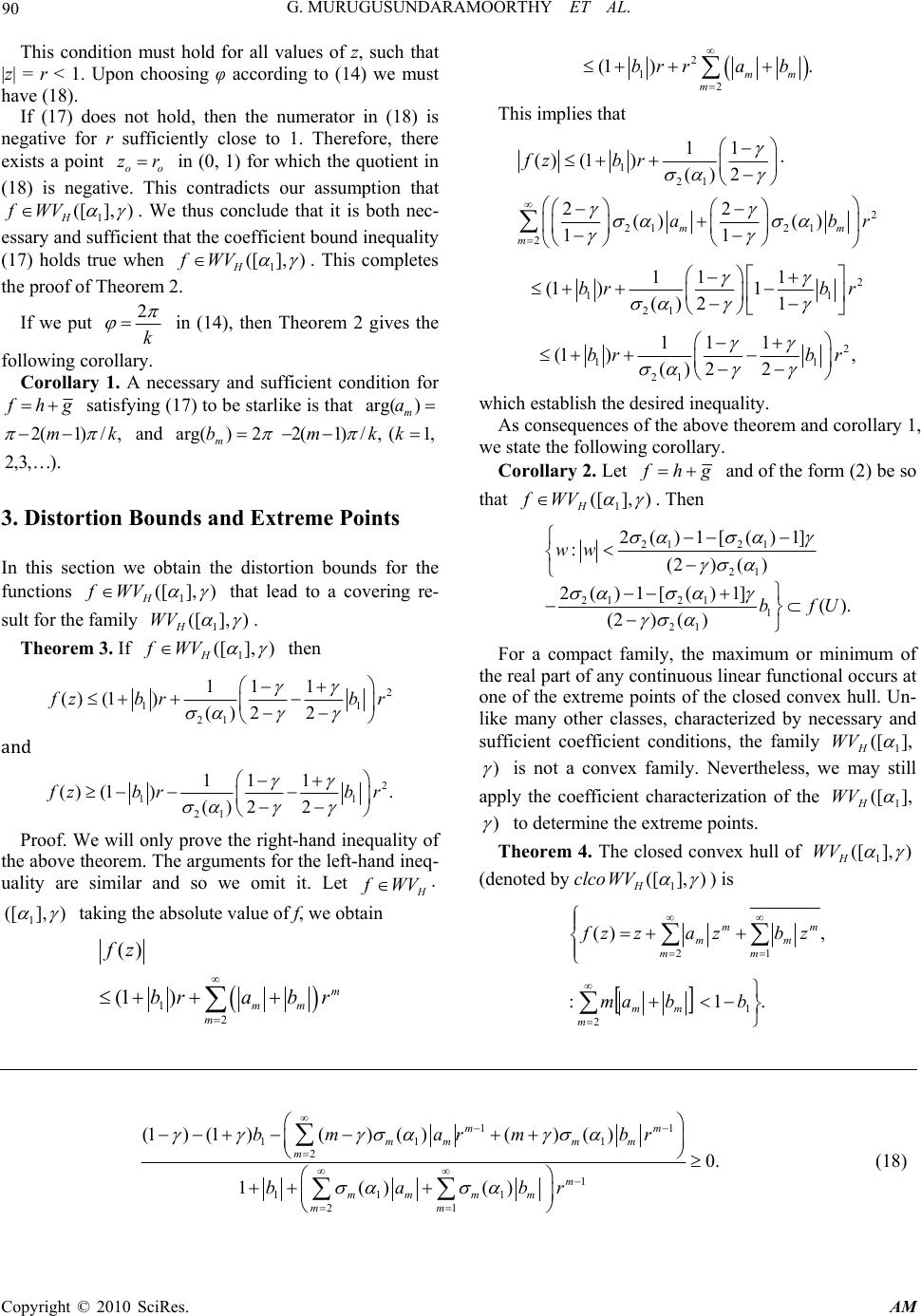 G. MURUGUSUNDARAMOORTHY ET AL. Copyright © 2010 SciRes. AM 90 This condition must hold for all values of z, such that |z| = r < 1. Upon choosing φ according to (14) we must have (18). If (17) does not hold, then the numerator in (18) is negative for r sufficiently close to 1. Therefore, there exists a point oo rz in (0, 1) for which the quotient in (18) is negative. This contradicts our assumption that )],([ 1 H WVf. We thus conclude that it is both nec- essary and sufficient that the coefficient bound inequality (17) holds true when )],([ 1 H WVf. This completes the proof of Theorem 2. If we put k 2 in (14), then Theorem 2 gives the following corollary. Corollary 1. A necessary and sufficient condition for ghf satisfying (17) to be starlike is that )arg( m a ,/)1(2 km and 2)arg( m b,/)1(2 km ,1( k ).,3,2 3. Distortion Bounds and Extreme Points In this section we obtain the distortion bounds for the functions )],([ 1 H WVf that lead to a covering re- sult for the family )],([ 1 H WV . Theorem 3. If )],([ 1 H WVf then 2 11 21 11 1 () (1)()22 f zbr br and 2 11 21 11 1 () (1). ()2 2 f zbrbr Proof. We will only prove the right-hand inequality of the above theorem. The arguments for the left-hand ineq- uality are similar and so we omit it. Let H f WV )],([ 1 taking the absolute value of f, we obtain 1 2 () (1 )m mm m fz brab r 2 1 2 (1 ). mm m br rab This implies that 1 21 2 21 21 2 11 () (1)()2 22 () () 11 mm m fzb r abr 2 11 21 11 1 (1 )1 ()21 brb r 2 11 21 11 1 (1 ), ()22 brb r which establish the desired inequality. As consequences of the above theorem and corollary 1, we state the following corollary. Corollary 2. Let ghf and of the form (2) be so that )],([ 1 H WVf . Then 21 21 21 21 21 1 21 2( )1[( )1] :(2)( ) 2()1[()1](). (2)( ) ww bfU For a compact family, the maximum or minimum of the real part of any continuous linear functional occurs at one of the extreme points of the closed convex hull. Un- like many other classes, characterized by necessary and sufficient coefficient conditions, the family ],([ 1 H WV ) is not a convex family. Nevertheless, we may still apply the coefficient characterization of the ],([ 1 H WV ) to determine the extreme points. Theorem 4. The closed convex hull of )],([ 1 H WV (denoted by clco )],([ 1 H WV ) is .1: ,)( 1 2 12 bbam zbzazzf m mm m m m m m m 11 11 1 2 1 11 1 21 (1)(1)() ()() () 0. 1()() mm mm mm m m mm mm mm bm arm br babr (18) 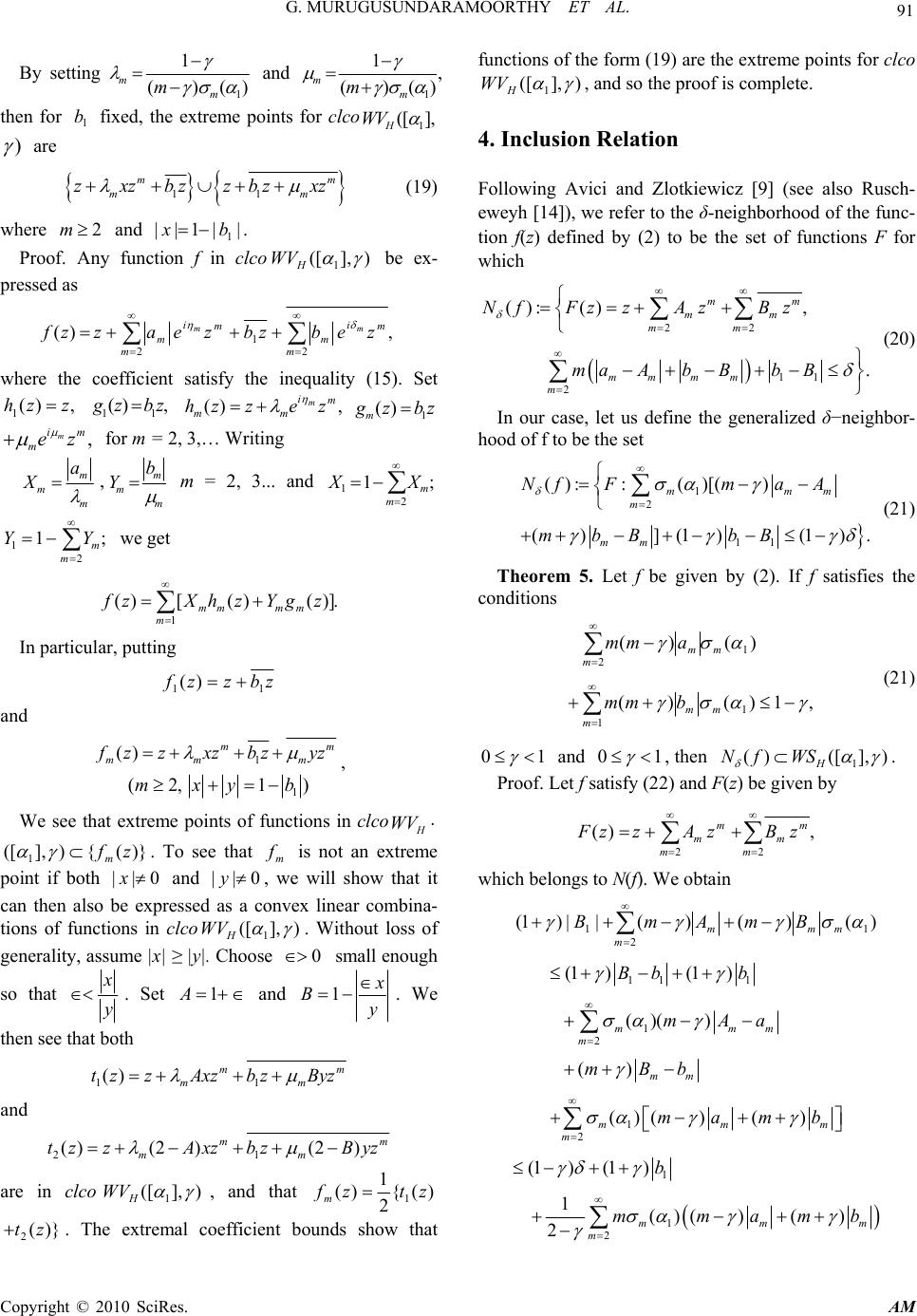 G. MURUGUSUNDARAMOORTHY ET AL. Copyright © 2010 SciRes. AM 91 By setting )()( 1 1 m mm and )()( 1 1 m mm , then for 1 b fixed, the extreme points for clco 1 ([ ], H WV ) are 11 mm mm zxzbzzbzxz (19) where 2m and ||1|| 1 bx . Proof. Any function f in clco )],([1 H WV be ex- pressed as ,)( 2 1 2 m m i m m m i mzebzbzeazzf mm where the coefficient satisfy the inequality (15). Set ,)( 1zzh ,)( 11 zbzg ,)( m i mm zezzh m 1 () m g zbz , m im mez for m = 2, 3,… Writing m m m a X ,m m m b Y m = 2, 3... and ;1 2 1 m m XX ;1 2 1 m m YY we get .)]()([)( 1 m mmmm zgYzhXzf In particular, putting zbzzf 11)( and m m m mmyzzbxzzzf 1 )( , 1 (2, 1)mxy b We see that extreme points of functions in clco H WV )}({)],([ 1zfm . To see that m f is not an extreme point if both 0|| x and 0|| y, we will show that it can then also be expressed as a convex linear combina- tions of functions in clco )],([1 H WV . Without loss of generality, assume |x| ≥ |y|. Choose 0 small enough so that y x . Set 1 A and y x B 1. We then see that both m m m mByzzbAxzzzt 11 )( and m m m myzBzbxzAzzt )2()2()( 12 are in clco )],([ 1 H WV , and that )({ 2 1 )( 1ztzfm )}( 2zt. The extremal coefficient bounds show that functions of the form (19) are the extreme points for clco )],([ 1 H WV , and so the proof is complete. 4. Inclusion Relation Following Avici and Zlotkiewicz [9] (see also Rusch- eweyh [14]), we refer to the δ-neighborhood of the func- tion f(z) defined by (2) to be the set of functions F for which 22 11 2 ():(), . mm mm mm mm mm m NfFz zAzBz maAbBb B (20) In our case, let us define the generalized δ−neighbor- hood of f to be the set 1 2 11 () ::()[() () ](1)(1). mmm m mm NfFmaA mbB bB (21) Theorem 5. Let f be given by (2). If f satisfies the conditions ,1)()( )()( 1 1 1 2 m mm m m m bmm amm (21) 10 and 10 , then )],([)( 1 H WSfN . Proof. Let f satisfy (22) and F(z) be given by ,)( 22 m m m m m mzBzAzzF which belongs to N(f). We obtain )()()(||)1( 1 2 1 mm m mBmAmB 111 1 2 1 2 (1 )(1 ) ()() () ()( )() mmm m mm mmm m Bb b mAa mBb mamb 1 1 2 (1 )(1 ) 1 ()()() 2mmm m b mmamb 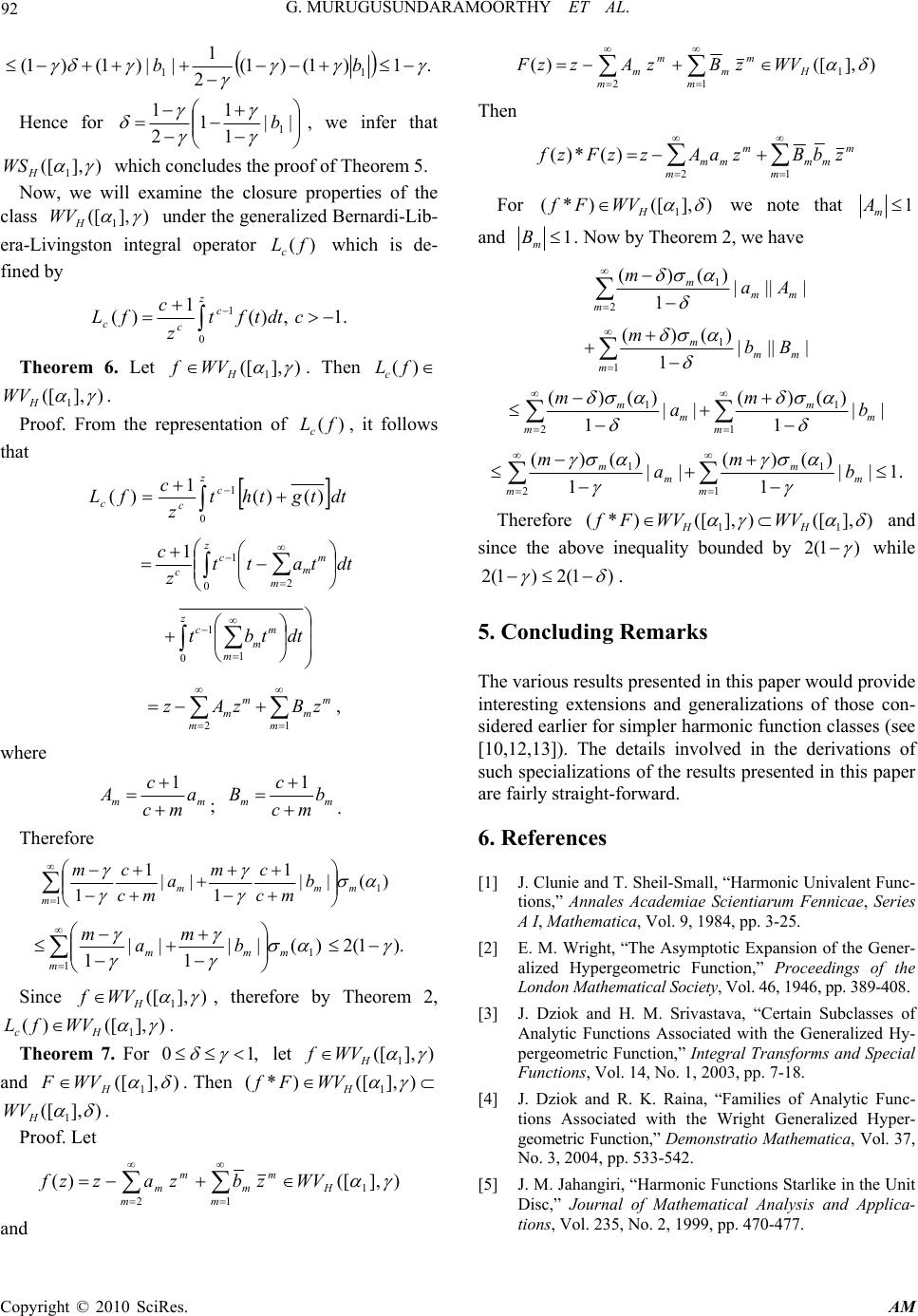 G. MURUGUSUNDARAMOORTHY ET AL. Copyright © 2010 SciRes. AM 92 .1)1()1( 2 1 ||)1()1( 11 bb Hence for || 1 1 1 2 1 1 b , we infer that )],([ 1 H WS which concludes the proof of Theorem 5. Now, we will examine the closure properties of the class )],([ 1 H WV under the generalized Bernardi-Lib- era-Livingston integral operator )( fLc which is de- fined by z c c ccdttft z c fL 0 1.1,)( 1 )( Theorem 6. Let )],([ 1 H WVf. Then )( fLc )],([ 1 H WV . Proof. From the representation of )( fLc, it follows that z c c cdttgtht z c fL 0 1)()( 1 )( z m m m c z m m m c c dttbt dttatt z c 01 1 02 1 1 12 m m m m m mzBzAz , where mma mc c A 1 ;mm b mc c B 1 . Therefore )(|| 1 1 || 1 11 1 m m mm b mc cm a mc cm )(|| 1 || 11 1 m m mm b m a m ).1(2 Since )],([ 1 H WVf , therefore by Theorem 2, )],([)(1 Hc WVfL. Theorem 7. For ,10 let )],([ 1 H WVf and )],([ 1 H WVF. Then )],([)*( 1 H WVFf )],([ 1 H WV . Proof. Let )],([)( 1 12 H m m m m m mWVzbzazzf and )],([)(1 12 H m m m m m mWVzBzAzzF Then 12 )(*)( m m mm m m mm zbBzaAzzFzf For )],([)*( 1 H WVFf we note that 1 m A and 1 m B. Now by Theorem 2, we have 1 1 2 1 |||| 1 )()( |||| 1 )()( m mm m m mm m Bb m Aa m 1 1 2 1|| 1 )()( || 1 )()( m m m m m mb m a m .1|| 1 )()( || 1 )()( 1 1 2 1 m m m m m mb m a m Therefore )],([)],([)*( 11 HH WVWVFf and since the above inequality bounded by )1(2 while )1(2)1(2 . 5. Concluding Remarks The various results presented in this paper would provide interesting extensions and generalizations of those con- sidered earlier for simpler harmonic function classes (see [10,12,13]). The details involved in the derivations of such specializations of the results presented in this paper are fairly straight-forward. 6. References [1] J. Clunie and T. Sheil-Small, “Harmonic Univalent Func- tions,” Annales Academiae Scientiarum Fennicae, Series A I, Mathematica, Vol. 9, 1984, pp. 3-25. [2] E. M. Wright, “The Asymptotic Expansion of the Gener- alized Hypergeometric Function,” Proceedings of the London Mathematical Society, Vol. 46, 1946, pp. 389-408. [3] J. Dziok and H. M. Srivastava, “Certain Subclasses of Analytic Functions Associated with the Generalized Hy- pergeometric Function,” Integral Transforms and Special Functions, Vol. 14, No. 1, 2003, pp. 7-18. [4] J. Dziok and R. K. Raina, “Families of Analytic Func- tions Associated with the Wright Generalized Hyper- geometric Function,” Demonstratio Mathematica, Vol. 37, No. 3, 2004, pp. 533-542. [5] J. M. Jahangiri, “Harmonic Functions Starlike in the Unit Disc,” Journal of Mathematical Analysis and Applica- tions, Vol. 235, No. 2, 1999, pp. 470-477. 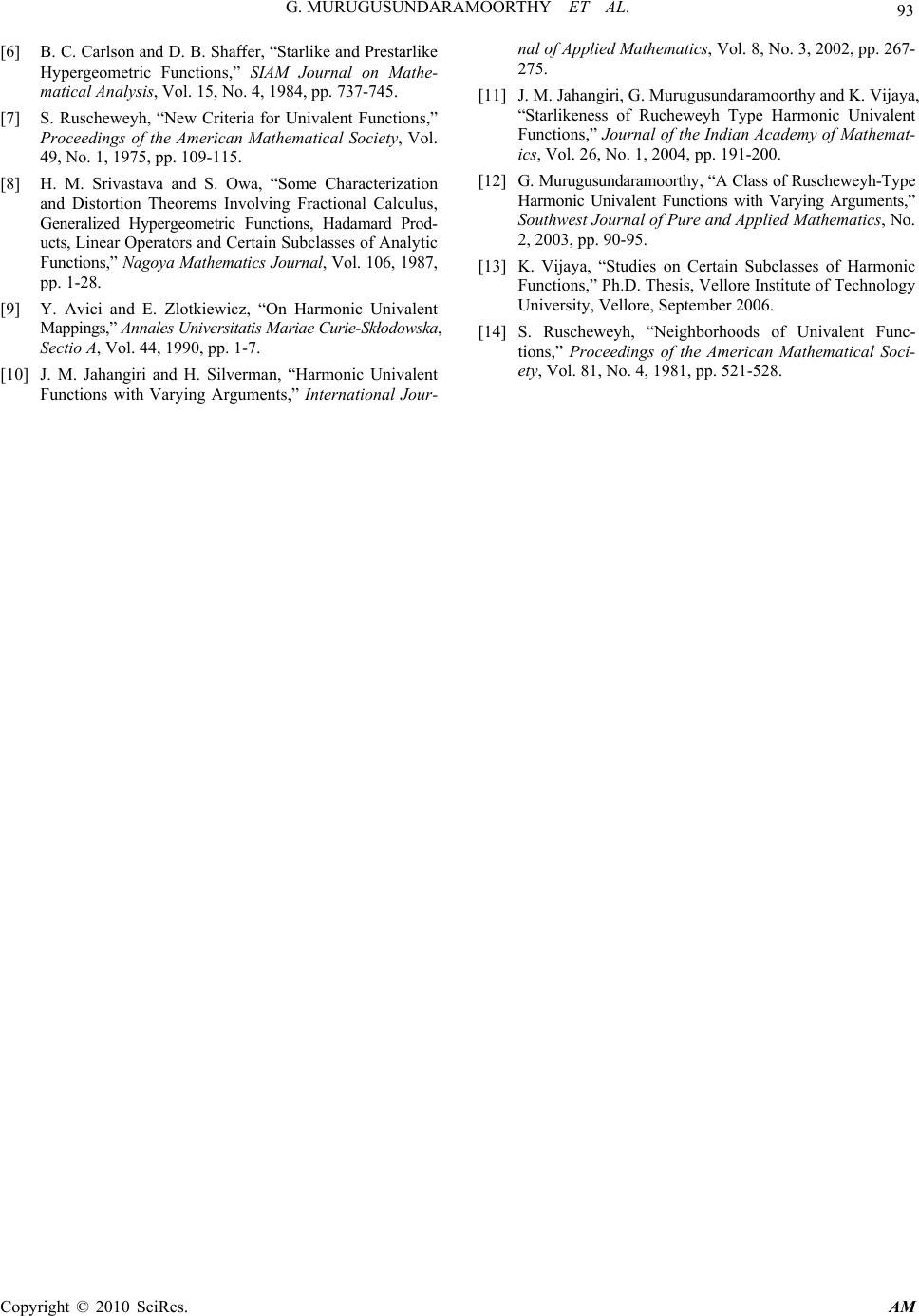 G. MURUGUSUNDARAMOORTHY ET AL. Copyright © 2010 SciRes. AM 93 [6] B. C. Carlson and D. B. Shaffer, “Starlike and Prestarlike Hypergeometric Functions,” SIAM Journal on Mathe- matical Analysis, Vol. 15, No. 4, 1984, pp. 737-745. [7] S. Ruscheweyh, “New Criteria for Univalent Functions,” Proceedings of the American Mathematical Society, Vol. 49, No. 1, 1975, pp. 109-115. [8] H. M. Srivastava and S. Owa, “Some Characterization and Distortion Theorems Involving Fractional Calculus, Generalized Hypergeometric Functions, Hadamard Prod- ucts, Linear Operators and Certain Subclasses of Analytic Functions,” Nagoya Mathematics Journal, Vol. 106, 1987, pp. 1-28. [9] Y. Avici and E. Zlotkiewicz, “On Harmonic Univalent Mappings,” Annales Universitatis Mariae Curie-Skłodowska, Sectio A, Vol. 44, 1990, pp. 1-7. [10] J. M. Jahangiri and H. Silverman, “Harmonic Univalent Functions with Varying Arguments,” International Jour- nal of Applied Mathematics, Vol. 8, No. 3, 2002, pp. 267- 275. [11] J. M. Jahangiri, G. Murugusundaramoorthy and K. Vijaya, “Starlikeness of Rucheweyh Type Harmonic Univalent Functions,” Journal of the Indian Academy of Mathemat- ics, Vol. 26, No. 1, 2004, pp. 191-200. [12] G. Murugusundaramoorthy, “A Class of Ruscheweyh-Type Harmonic Univalent Functions with Varying Arguments,” Southwest Journal of Pure and Applied Mathematics, No. 2, 2003, pp. 90-95. [13] K. Vijaya, “Studies on Certain Subclasses of Harmonic Functions,” Ph.D. Thesis, Vellore Institute of Technology University, Vellore, September 2006. [14] S. Ruscheweyh, “Neighborhoods of Univalent Func- tions,” Proceedings of the American Mathematical Soci- ety, Vol. 81, No. 4, 1981, pp. 521-528. |

